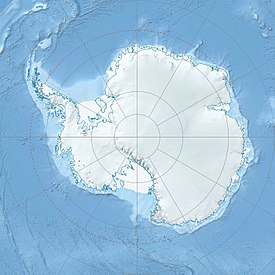Jinnah Antarctic Station
This article needs additional citations for verification. (August 2015) |
Jinnah Antarctic Station
جناح جنوبی قطب اسٹیشن | |
|---|---|
 Jinnah Antarctic Station Location of the Jinnah Antarctic Station in Antarctica | |
| Coordinates: 70°24′00″S 25°45′00″E / 70.3999984°S 25.749997°ECoordinates: 70°24′00″S 25°45′00″E / 70.3999984°S 25.749997°E | |
| Country | |
| Location in Antarctica | Sør Rondane Mountains, Queen Maud Land; claimed by Norway. |
| Administered by | Pakistan Antarctic Programme, under the Ministry of Science and Technology |
| Established | 15 January 1991 (31 years ago) |
| Named for | Muhammad Ali Jinnah |
| Time zone | UTC+3 (SYOT) |
| Type | Seasonal |
| Period | Summer |
| Status | Operational |
| Website | National Institute of Oceanography Pakistan |
The Jinnah Antarctic Station (JAS) is an Antarctic scientific research station operated by the Pakistan Antarctic Programme.[2][3] It is located in the vicinity of the Sør Rondane Mountains, Queen Maud Land,[4] in East Antarctica.[3]
History[]
Pakistan signed the Scientific Committee on Antarctic Research (SCAR) in 1991. The programme was launched by the National Institute of Oceanography, with the support of the Ministry of Science and Technology. The program was led by the Pakistan Navy, as it had provided the logistical support for the programme. In 1991, the Jinnah Antarctic Station was established. Pakistan maintains one summer research station and one weather observatory in the vicinity of the Sør Rondane Mountains.
Facilities[]
The facilities were quickly expanded by the NIO. Government advisors belonging to the Ministry of Science and Technology frequently visited the area. Pakistani naval engineers and scientists oversaw the development of the base. By 1994 it was a comfortable, technologically advanced operational base. In 2001, the data operational system was linked to the Badr-B satellite, beginning regular transmission of digital imagery of the region to NIO headquarters in Karachi. In 2002, SUPARCO scientists visited the base, where they set up and installed an advanced, supercomputer-equipped facility, run by the NIO and SUPARCO's scientists. In 2005, Pakistan Air Force engineers and scientists built a small airstrip, and a control room to monitor flights to and from Pakistan. In 2010, Pakistan's government approved a plan to expand the JAS facility into a permanent operational base.[5][failed verification]
Foreign cooperation[]
Communication gears were set up with the United States' Antarctic Program.
US-Pakistani research[]
In contemporary times, the JAS is frequently visited by US scientists who conduct their research with their Pakistani counterparts.
See also[]
- List of Antarctic research stations
- List of Antarctic field camps
References[]
- ^ "Pakistan Scientific Expedition to Antarctica 1991". www.istampgallery.com. 5 January 2017. Archived from the original on 11 January 2020. Retrieved 7 October 2020.
- ^ Mills, J.M. (2003). Exploring polar frontiers: a historical encyclopedia. 1 (A–M). Santa Barbara: ABC-CLIO.
- ^ a b "Antarctic Research". Pakistan: National Institute of Oceanography. Archived from the original on 15 August 2010.
- ^ subject to a territorial claim by the Kingdom of Norway.
- ^ Molle, Kris (29 October 2010). "Pakistan and Antarctica". The Polar Conservation Organisation. Archived from the original on 28 January 2012.
External links[]
- Outposts of Antarctica
- Pakistan Antarctic Programme
- Nawaz Sharif administration
- History of science and technology in Pakistan
- 1991 establishments in Antarctica
- Memorials to Muhammad Ali Jinnah

